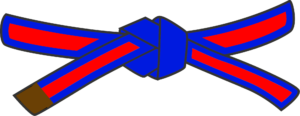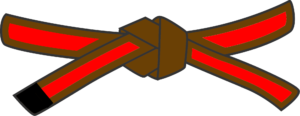Kyushin Ryu Belt System
Before the 20th century most belts were colourless, but since students were prohibited from washing their belts, the belts grew steadily darker through the years of accumulated sweat and soil. If the belt or Obi in Japanese) comes undone during practice, martial arts etiquette is observed. The wearer turns around, facing away from their partner, and re-ties their belt before turning back again. In accordance with ancient Oriental philosophy, there is a balance of ten student grades and ten master grades. The kyu (student) grades are:
Jukkyu – Yellow Belt
Sub-Junior
(under 10 years)

Junior
(10-13 years)

Senior
(14+ years)

Kyukyu – Yellow Belt Orange Tip
Sub-Junior
(under 10 years)

Junior
(10-13 years)

Senior
(14+ years)

Hachikyu – Orange Belt
Sub-Junior
(under 10 years)

Junior
(10-13 years)

Senior
(14+ years)

Nanakyu – Orange Belt Green Tip
Sub-Junior
(under 10 years)

Junior
(10-13 years)

Senior
(14+ years)

Rokkyu – Green Belt
Sub-Junior
(under 10 years)

Junior
(10-13 years)

Senior
(14+ years)

Gokyu – Green Belt Blue Tip
Sub-Junior
(under 10 years)

Junior
(10-13 years)

Senior
(14+ years)

Yonkyu – Blue Belt
Sub-Junior
(under 10 years)

Junior
(10-13 years)

Senior
(14+ years)

Sankyu – Blue Belt Brown Tip
Sub-Junior
(under 10 years)

Junior
(10-13 years)

Senior
(14+ years)

Nikyu – Brown Belt
Sub-Junior
(under 10 years)

Junior
(10-13 years)

Senior
(14+ years)

Ikkyu – Brown Belt Black Tip
Sub-Junior
(under 10 years)

Junior
(10-13 years)

Senior
(14+ years)

Shodan – Black Belt 1st Degree

Nidan – Black Belt 2nd Degree

Sandan – Black Belt 3rd Degree

Yondan – Black Belt 4th Degree


Godan – Black Belt 5th Degree


Rokudan – Black Belt 6th Degree


Shichidan – Black Belt 7th Degree


Hachidan – Black Belt 8th Degree


Kudan – Black Belt 9th Degree


Judan – Black Belt 10th Degree


Sixth, seventh and eighth degree holders have the option of wearing a black belt with the relevant number of red strips, or wearing the ceremonial red and white belt. In similar fashion, the ninth and tenth degree holders may wear a black belt or red belt.
The Sub-junior grades (under 10 years) are denoted by a full coloured belt. Junior grades (under 14 years) are denoted by a coloured belt with a white stripe down the centre. Senior grades (14 years and over) are denoted by a coloured belt with a red stripe down the centre.
At all levels, the rank of the wearer is indicated on the right side of the knot.
Promotional examinations are usually conducted four times a year. The aim of the examinations is to provide members with the opportunity to be awarded a higher belt in recognition of the progress that they have made since the last promotion. Depending on their knowledge, physical abilities and commitment, it is recognised that members may progress at different paces. Accordingly, it is possible to skip a level, particularly in the lower belts.
The origins of the coloured belt systems
(from a Japanese point of view)
‘Belts’ are used in Japanese martial arts as a description of rank or experience. It seems that this idea gained somewhat in popularity around the early to mid part of this century, influencing other styles. In Kung-fu a similar approach is taken, only they use a coloured sash instead. As for Korean styles, I believe there belt systems were copied from Japan as they use identical belts with similar colours, but I am not too sure on this point. The concept was very simple – you start with a white belt, end of story!
In early martial art training the colour white was simply to match your clothing which was of a simple style (you dont wear your best tunic to roll around on the floor). Your belt really was only to hold your trousers up. As time progresses, the belt became dirty turning in to a darker colour. The suit (gi) would be washed for hygiene reasons, but the belt (obi) was not really very important so would get no more than a brushing or quick soke.
In time this lead to a simple rule of thumb to how much ‘mat time’ someone had accumulated – the dirtier the belt the more experience.
When the belt system was originally introduced, there were only three colours, white green and black. In time more colours joined this list, mainly due to Western influences. Today there can be between 5 and 10 different coloured ranking belts, including black in a given martial art style.
All colours except black are called kyu grades, a black belt is the first dan grade. This marks the completion of basic training and the start of ‘mastering’ an art, hence so much emphasis is placed upon getting a black belt.
